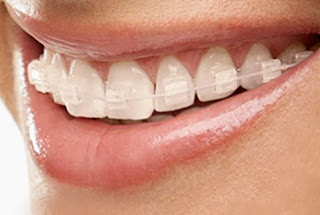Dental Ceramics : Veneers , Crowns , Inlays , Orthodontic brackets

The first recorded attempt to use ceramics as replacements for teeth was in about 1774, in Paris, France, by a dentist, Nicholas Dubois de Chémant. Before that time, many other materials had been used to replace teeth, including ivory, bone, wood, animal teeth, and even teeth extracted from human donors. These prior tooth replacements weren’t particularly effective, because they quickly became stained and invariably developed a bad odor.
Since 1774, and especially during the past 40 years, dental ceramics have been refined to duplicate the color and translucency of natural teeth and to provide higher strength. Ceramics have been used for tooth replacement and for dentures, and new restoration techniques, such as veneers, inlays, and crowns have also been developed. A veneer consists of a thin layer of ceramic, usually bonded to the visible surface of front teeth. An inlay is a filling. A ceramic inlay provides a natural-colored alternative to repairing a cavity with a silver-tin-mercury filling. A crown is a hollow ceramic cap, or shell, that completely covers the outer surface of a tooth.


What are Dental Veneers?
Dental veneers (sometimes called porcelain veneers or dental porcelain laminates) are wafer-thin, custom-made shells of tooth-colored materials designed to cover the front surface of teeth to improve your appearance. These shells are bonded to the front of the teeth changing their color, shape, size, or length.
Preparation
To prepare a tooth for a veneer, your dentist will reshape the tooth surface, which is an amount nearly equal to the thickness of the veneer to be added to the tooth surface. You and your dentist will decide whether they numb the area before trimming off the enamel. Next, your dentist will make a model, or impression, of your tooth. This model is sent out to a dental laboratory, which makes your veneer. It usually takes 2-4 weeks for the veneers to come back from the laboratory. Temporary dental veneers can be used in the meantime.
Bonding
Your dentist will place the veneer on your tooth to examine its fit and color, repeatedly removing and trimming the veneer to achieve the proper fit, before permanently cementing it to your tooth. The veneer color can be adjusted with the shade of cement to be used. Next, to prepare your tooth to receive the veneer, your tooth will be cleaned, polished, and etched. Etching roughens the tooth to allow for a strong bonding process. A special cement is applied to the veneer and it is then placed on your tooth. Once the veneer is properly positioned, your dentist will shine a special light beam on it to activate chemicals in the cement, causing it to harden very quickly. The final steps involve removing any excess cement, checking your bite and making any needed adjustments. Your dentist may ask you to return for a follow-up visit in a couple of weeks to check your gums and the veneer's placement.
For complete case study click on the link below
ncbi.nlm.nih.gov/pmc/articles/PMC4053676/
Dental Crowns
A crown, or dental cap, is a type of dental restoration which completely caps or encircles a tooth or dental implant. A crown may be needed when a large cavity threatens the health of a tooth. They are typically bonded to the tooth by dental cement.
Full ceramic crowns
Dental ceramics or porcelains are used for crowns manufacture primarily for their aesthetic properties compared to all metal restorations. These materials are generally quite brittle and prone to fracture. Many classifications have been used to categorise dental ceramics, with the simplest, based on the material from which they are made, i.e. silica, alumina or zirconia.
Silica
Silica-based ceramics are highly aesthetic due to their high glass content and excellent optical properties due to the addition of filler particles which enhance opalescence, fluorescence which can mimic the colour of natural enamel and dentine. These ceramics, however, suffer from poor mechanical strength, and therefore often used for veneering stronger substructures.
Examples include aluminosilicate glass, e.g. feldspathic, synthetic porcelain, and leucite reinforced ceramics.
Mechanical properties can be improved by the addition of filler particles, e.g. lithium disilicate, and are therefore termed glass ceramics.
Alumina
Alumina was introduced as a dental substructure (core) in 1989 when the material was slip cast, sintered, and infiltrated with glass. More recently, glass-infiltrated alumina cores are produced by electrophoretic deposition, a rapid nanofabricating process. During this process particles of a slip are brought to the surface of a dental die by an electric current, thereby forming a precision-fitting core greenbody in seconds. Margins are then trimmed and the greenbody is sintered and infiltrated with glass. Glass-infiltrated alumina has significantly higher porcelain bond strength over CAD/CAM produced zirconia and alumina cores without glass.
Zircona
Yttria-stabilized zirconia, also known simply as zirconia, is a very hard ceramic that is used as a strong base material in some full ceramic restorations. Zirconia is relatively new in dentistry and the published clinical data is correspondingly limited. The zirconia used in dentistry is zirconium oxide which has been stabilized with the addition of yttrium oxide. Yttria-stabilized zirconia is also known as YSZ.

Orthodontic brackets
Ceramics are also gaining importance in the field of orthodontics (the aligning of teeth that are crooked and out of place). To align teeth, an orthodontist cements a bracket onto each tooth and stretches a metal wire across the brackets to apply a steady pressure to push the teeth into place. The brackets traditionally have been metal, but the bright metal is so readily visible that some people are reluctant or embarrassed to have orthodontic braces. Initial attempts to replace the metal brackets with ceramics weren’t successful. The stress caused when the orthodontist cinched up the wire was too great, and the ceramic usually broke. However, during the early 1980s, sapphire brackets were successfully introduced, and soon, translucent polycrystalline alumina brackets followed. These ceramic braces, which are much less visible than metal braces, are now highly popular.





Comments
Post a Comment